When it comes down to tench fishing there are just two methods that are used: float fishing or legering. The decision of when to use either is usually decided by either the distance needed to fish to reach the feeding tench, or by the weather conditions – as in can be very hard to fish the float properly in very windy conditions. It can also come down to a favoured style of fishing too and I must confess that I love to catch tench on the lift method but, sadly, the chances I get to fish that way on my current tench waters are all too infrequent.
Where possible my rig for fishing the lift is pretty simple, as all good angling rigs should be. I use a very buoyant straight waggler made from peacock quill with a loading of 3 SSG. I don’t fish any shot near the float at all, in fact I stop the float by either a commercial rubber float stop or by a sliding stop knot. Then, three feet from the hook, I put a small shot a No. 4 or similar; this is simply to stop the float tangling around the hook as the only other shot, a 2x SSG, is placed about six inches from the hook.
All you do then is cast out and allow the bait to sink on a slack line – if you have it too tight the whole rig will drag towards you. Once the bait has settled, tighten down until only half an inch of the float is showing; when you get a bite the float will either sink slowly away or shoot from the water like a missile. It’s a wonderful way of fishing for tench and very traditional but it’s not one that I get to use enough, what is more commonplace on the waters I tend to fish is my next method: bolt legering.
The rig that I use for this is, I think, just a little bit special and though the chances are that someone somewhere will have come to the same conclusions before or after me and will have made something similar but I am laying claim to my own “Tench Choddy Rig” and here is how to make one!
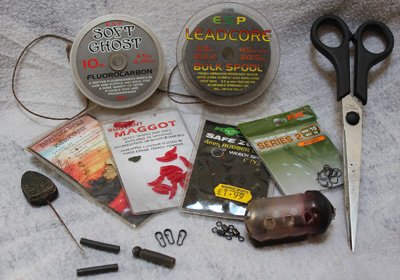 1) These are the components that you will need. Of course you can substitute any part of the rig for something similar made by a different manufacturer, I am simply illustrating the piece with exactly the components I use to create my rig.
1) These are the components that you will need. Of course you can substitute any part of the rig for something similar made by a different manufacturer, I am simply illustrating the piece with exactly the components I use to create my rig.
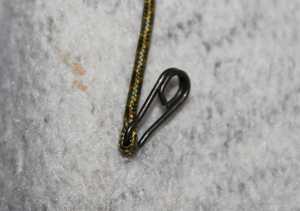 2) First off start by making a lead core leader of about three feet in length. Then, using a splicing needle, splice two loops – one at either end of the leader and to one end of the leader attach a quick change clip.
2) First off start by making a lead core leader of about three feet in length. Then, using a splicing needle, splice two loops – one at either end of the leader and to one end of the leader attach a quick change clip.
3) Then thread onto the line the bottom helicopter bead, the one with the sleeve attached and follow this by adding on a swivel with another quick change clip attached to it onto the leader – this is where you will attach your hook length.

4) Then add the second heli bead. With the two beads in place add a small sleeve of silicone to the leader and slide it down towards the two beads. This silicone should grip the leader fairly lightly; light enough that the bead will either pass over the silicone or the silicone slide down the leader if pressure is applied to the bead in the event of a break off.
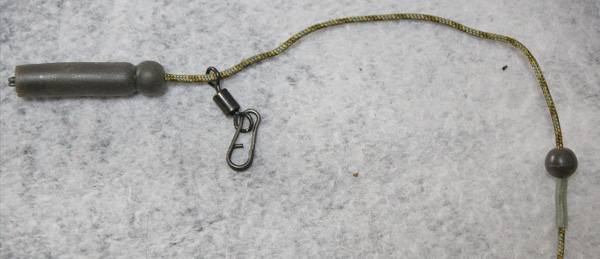
5) Now add your choice of feeder or lead to the first quick change clip that you fitted and pull the bottom heli bead down tight over the clip and feeder swivel. Now take the silicone sleeve and set the gap between the two beads at around the same length as any weed that you want to fish over is high. You are now ready for your hooklength.

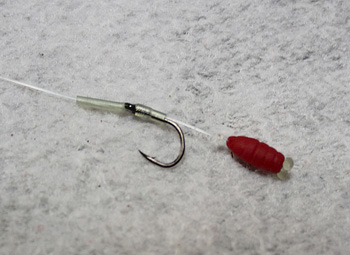 6) Take a length of soft 10lb breaking strain fluorocarbon and make a small loop at one end. Thread onto this loop lengthways an artificial caster and stop it with a boilie stop. Then tie a knotless knot so that the caster sits just below the bend of the hook and finish it off with a length of silicone to cover the knot and straighten the angle of the line and hook. Fluoro will tend to kick over without it and this is a poor set up for tench.
6) Take a length of soft 10lb breaking strain fluorocarbon and make a small loop at one end. Thread onto this loop lengthways an artificial caster and stop it with a boilie stop. Then tie a knotless knot so that the caster sits just below the bend of the hook and finish it off with a length of silicone to cover the knot and straighten the angle of the line and hook. Fluoro will tend to kick over without it and this is a poor set up for tench.
7) Finish the other end of the hooklength off with a loop and a short length of silicone sleeve – I find the ideal length is three to five inches – attach it to the clip and there is your finished rig.
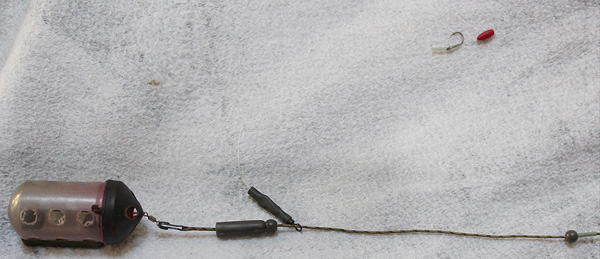
You might look at this and say what’s so special about it? Well to put it simply it’s a great rig as it allows you to fish baits effectively in light weed, which is exactly where the tench want to feed and where they do so most confidently.
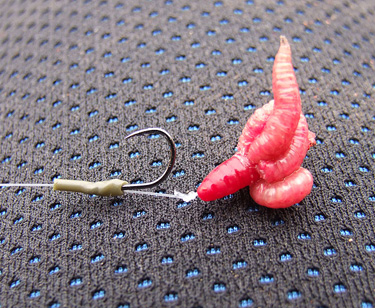 The final touch I make to the rig before casting is to add some maggots to the hair and this I do by simply super-glueing a few maggots to the artificial caster. I then encase the hookbait in dissolving foam.
The final touch I make to the rig before casting is to add some maggots to the hair and this I do by simply super-glueing a few maggots to the artificial caster. I then encase the hookbait in dissolving foam.
When you cast, the natural action as the rig falls through the water pushes the hooklength and foam backwards to rest against the top bead. As the feeder touches down the leadcore pulls the rig down whilst the hooklength floats straight up until the foam melts, at which point the bait falls gently down onto the top of the weed, exactly where you want it. I also use this rig for casters, the change being that instead of having a single caster mounted lengthways on the hair, I have three casters mounted sideways.
So, with tackle and rigs all sorted, it’s time to catch some tench and in the next part I will cover how we go about that once we get to the bank.










